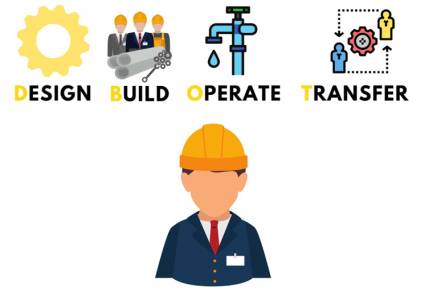Description
Design-Build-Operate-Transfer (DBOT) – A Comprehensive Project Delivery Solution
The Design-Build-Operate-Transfer (DBOT) model is a sophisticated public-private partnership (PPP) procurement method used for large-scale infrastructure projects. It streamlines the traditionally fragmented project lifecycle, offering significant advantages in efficiency, cost-effectiveness, and risk management. This description details the key aspects of the DBOT approach.
What is DBOT?
DBOT consolidates the design, construction, operation, and transfer of a project into a single contract awarded to a private sector consortium or entity. This "single-point-of-responsibility" approach contrasts with traditional methods where different entities handle each phase, often leading to coordination challenges and delays.
Here's a breakdown of each phase:
- Design: The private sector partner is responsible for the detailed design of the project, often working closely with the public sector to ensure alignment with specifications and requirements. This collaborative design phase fosters innovation and efficiency.
- Build: The same private partner handles the construction phase, ensuring seamless transition from design to implementation. This eliminates potential conflicts and delays often associated with separate design and construction contracts.
- Operate: Following completion, the private partner operates and maintains the facility for a predetermined period, typically receiving payment based on performance-related metrics (e.g., availability, efficiency, service levels). This ensures optimal performance and reduces the burden on the public sector.
- Transfer: After the operational period, ownership and responsibility for the facility are transferred back to the public sector. This transfer typically includes the infrastructure in good working condition, along with any necessary documentation and training.
Key Advantages of DBOT:
- Reduced Project Time: The integrated nature of DBOT streamlines the entire process, resulting in faster project delivery compared to traditional methods.
- Cost Efficiency: Integrated responsibility and optimized design often lead to lower overall project costs, thanks to reduced coordination issues and potential cost overruns.
- Risk Mitigation: The private sector partner assumes a significant portion of the project risk, including design, construction, and operational risks. This reduces the financial and operational burden on the public sector.
- Improved Quality: The integrated approach encourages a focus on quality throughout the project lifecycle, as the private partner is responsible for the entire process, from design to operation.
- Innovation and Technological Advancement: The private sector's expertise and incentive to optimize operations often lead to the adoption of innovative technologies and best practices.
- Enhanced Project Management: A single contract with a single responsible party simplifies project management and monitoring for the public sector.
Suitable Projects for DBOT:
DBOT is particularly well-suited for complex and large-scale infrastructure projects such as:
- Transportation infrastructure: Highways, bridges, railways, airports, and ports.
- Utilities: Water treatment plants, power plants, and waste management facilities.
- Social infrastructure: Hospitals, schools, and other public facilities.
Considerations for DBOT Implementation:
- Contract Negotiation: Developing a comprehensive and robust contract is crucial to clearly define responsibilities, risks, and payment mechanisms.
- Risk Allocation: Carefully considering and allocating risks between the public and private sectors is vital for project success.
- Regulatory Framework: A supportive regulatory environment and clear guidelines are essential for effective DBOT implementation.
- Performance Monitoring: Establishing effective mechanisms for monitoring and evaluating the private partner's performance is crucial.
In conclusion, the Design-Build-Operate-Transfer model offers a compelling approach for delivering large-scale infrastructure projects efficiently, cost-effectively, and with reduced risk. Its integrated nature promotes collaboration, innovation, and ultimately, better value for the public sector.
